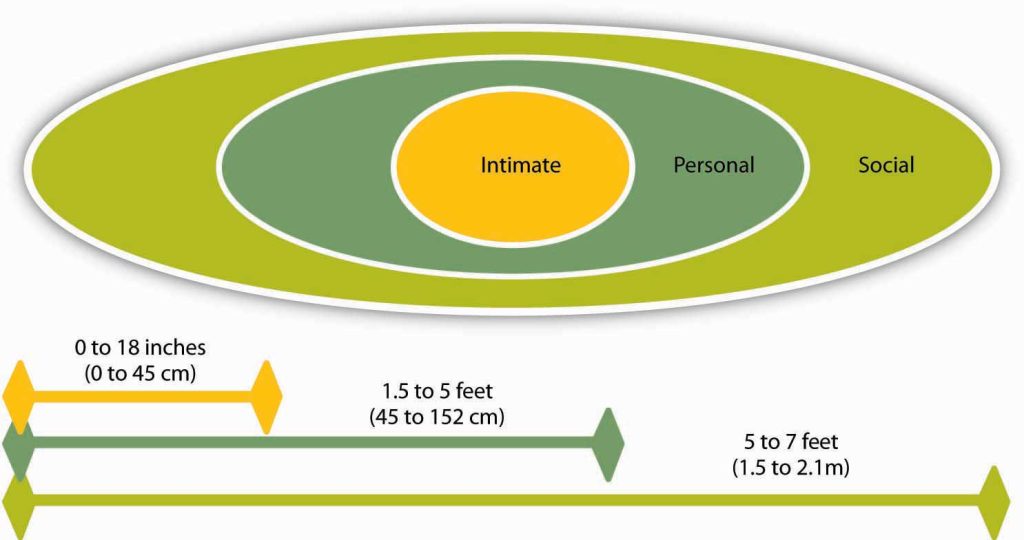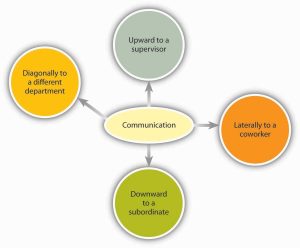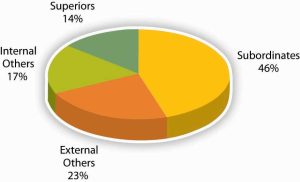8.2 Different Types of Communication and Channels
Learning Objectives
- List different types of communication.
- Outline how communication channels affect communication.
- Recognize different communication directions within organizations.
There are three types of communication: verbal communication, involving listening to a person to understand the meaning of a message; written communication, in which a message is read; and nonverbal communication, involving observing a person and inferring meaning. Let’s start with verbal communication, which is the most common form of communication.
Verbal Communication
Verbal communications in business take place over the phone or in person. The medium of the message is oral.
Example
Let’s return to our golf cart example. This time, the message is being conveyed from the sender (the manager) to the receiver (an employee named Bill) by phone. We’ve already seen how the manager’s request to Bill (“Bring around more golf carts from the shed!”) can go awry. Now let’s look at how the same message can travel successfully from sender to receiver.
Manager (speaking on the phone): “Good morning, Bill!”
(By using the employee’s name, the manager is establishing a clear, personal link to the receiver.)
Manager: “You’re doing a great job.”
(The manager’s recognition of Bill’s role in a winning team further personalizes and emotionalizes the conversation.)
Manager: “We need to maintain the right number of golf carts in the staging area outside the pro shop and ensure the proper rotation of the golf cart fleet. I would suggest at busy times we have 12 golf carts staged every 30 minutes.”
(The manager breaks down the task into several steps. Each step consists of a specific task, time frame, quantity, or goal.)
Bill: “Sure thing! I’ll make sure to let the back shop staff know of your instructions… 12 golf carts staged every 30 minutes ”
(Bill, a model employee, repeats what he has heard. This is the feedback portion of the communication. Feedback helps him recognize any confusion he may have had hearing the manager’s message. Feedback also helps the manager hear if she has communicated the message correctly.)
Storytelling has been shown to be an effective form of verbal communication that serves an important organizational function by helping to construct common meanings for individuals within the organization. Stories can help clarify key values and also help demonstrate how certain tasks are performed within an organization. Story frequency, strength, and tone are related to higher organizational commitment (McCarthy, 2008). The quality of the stories is related to the ability of entrepreneurs to secure capital for their firms (Martens, Jennings, & Devereaux, 2007).
While the process may be the same, high-stakes communications require more planning, reflection, and skill than normal day-to-day interactions at work. Examples of high-stakes communication events include asking for a raise or presenting a business plan to the owner regarding a pro shop expansion. In addition to these events, there are also many times in our professional lives when we have crucial conversations, which are defined as discussions in which not only are the stakes high, but also the opinions vary and emotions run strong (Patterson et al., 2002). One of the most consistent recommendations from communications experts is to work toward using “and” instead of “but” when communicating under these circumstances. In addition, be aware of your communication style and practice being flexible; it is under stressful situations that communication styles can become the most rigid.
OB Toolbox: 10 Recommendations for Improving the Quality of Your Conversations
- Be the first to say hello. Use your name in your introduction, in case others have forgotten it.
- Think before you speak. Our impulse is often to imitate movies by offering fast, witty replies in conversation. In the real world, a careful silence can make us sound more intelligent and prevent mistakes.
- Be receptive to new ideas. If you disagree with another person’s opinion, saying, “Tell me more,” can be a more useful way of moving forward than saying, “That’s stupid!”
- Repeat someone’s name to yourself and then aloud, when being introduced. The form of the name you use may vary. First names work with peers. Mr. or Ms. is common when meeting superiors in business.
- Ask questions. This establishes your interest in another person.
- Listen as much, if not more, than you speak. This allows you to learn new information.
- Use eye contact. Eye contact shows that you are engaged. Also, be sure to smile and make sure your body language matches your message.
- Mirror the other person. Occasionally, repeat what they’ve said in your own words. “You mean… ?”
- Have an exit strategy ready. Ideal conversations are brief, leaving others wanting more.
- Be prepared. Before beginning a conversation, have three simple facts about yourself and four questions about someone else in mind.
(Gabor, 1983; Post, 2005).
Written Communication
In contrast to verbal communications, which are oral, written business communications are printed messages. Examples of written communications include memos, proposals, text messages, e-mails, letters, training manuals, and operating policies. They may be printed on paper or appear on the screen. Written communication is often asynchronous. That is, the sender can write a message that the receiver can read at any time, unlike a conversation that is carried on in real time. A written communication can also be read by many people (such as all employees in a department or all customers). It’s a “one-to-many” communication, as opposed to a one-to-one conversation. There are exceptions, of course: A voice mail is an oral message that is asynchronous. Conference calls and speeches are oral one-to-many communications, and e-mails can have only one recipient or many.
Normally, verbal communication takes place in real time. Written communication, by contrast, can be constructed over a longer period of time. It can also be collaborative. Multiple people can contribute to the content on one document before that document is sent to the intended audience.
Verbal and written communications have different strengths and weaknesses. In business, the decision to communicate verbally or in written form can be a powerful one. As we’ll see below, each style of communication has particular strengths and pitfalls. When determining whether to communicate verbally or in writing, ask yourself: Do I want to convey facts or feelings? Verbal communications are a better way to convey feelings. Written communications do a better job of conveying facts.
Picture a turf manager making a speech to a team of 20 turf employees. The manager is speaking at a normal pace. The employees appear interested. But how much information is being transmitted? Probably not as much as the speaker believes. The fact is that humans listen much faster than they speak. The average public speaker communicates at a speed of about 125 words a minute, and that pace sounds fine to the audience. (In fact, anything faster than that probably would sound unusual. To put that figure in perspective, someone having an excited conversation speaks at about 150 words a minute.) Based on these numbers, we could assume that the audience has more than enough time to take in each word the speaker delivers, which actually creates a problem. The average person in the audience can hear 400 to 500 words a minute (Lee & Hatesohl, 2008). The audience has more than enough time to hear. As a result, their minds may wander.
As you can see, oral communication is the most often used form of communication, but it is also an inherently flawed medium for conveying specific facts. Listeners’ minds wander. It’s nothing personal—in fact, it’s a completely normal psychological occurrence. In business, once we understand this fact, we can make more intelligent communication choices based on the kind of information we want to convey.
Nonverbal Communication

What you say is a vital part of any communication. Surprisingly, what you don’t say can be even more important. According to one study, only 7% of a receiver’s comprehension of a message is based on the sender’s actual words, 38% is based on paralanguage (the tone, pace, and volume of speech), and 55% is based on nonverbal cues (body language) (Mehrabian, 1981). To be effective communicators, our body language, appearance, and tone must align with the words we’re trying to convey. Research shows that when individuals are lying, they are more likely to blink more frequently, shift their weight, and shrug (Siegman, 1985).
In the case of performance athletes such as Tiger Woods, they communicate through performance and their non-verbal actions during competition. It is clear to the viewer when a golfer hits a good shot or misses an important putt by their actions and mannerisms. If the golfer hits a bad shot and throws their golf club in the pond or snaps it over their knee, it is clear they are not happy with their performance!
A different tone can change the perceived meaning of a message. See the table below for how clearly this can be true. If we only read these words, we would be left to wonder, but during a conversation, the tone conveys a great deal of information.
Don’t Use That Tone With Me!
Changing your tone can dramatically change your meaning.
| Placement of the emphasis | What it means |
|---|---|
| I did not tell John you were late. | Someone else told John you were late. |
| I did not tell John you were late. | This did not happen. |
| I did not tell John you were late. | I may have implied it. |
| I did not tell John you were late. | But maybe I told Sharon and José. |
| I did not tell John you were late. | I was talking about someone else. |
| I did not tell John you were late. | I told him you are still late. |
| I did not tell John you were late. | I told him you were attending another meeting. |
(Kiely, 1993).
The following are a few examples of nonverbal cues that can support or detract from a sender’s message.
 Body Language
Body Language
A simple rule of thumb is that simplicity, directness, and warmth convey sincerity. Sincerity is vital for effective communication. In some cultures, a firm handshake, given with a warm, dry hand, is a great way to establish trust. A weak, clammy handshake might convey a lack of trustworthiness. Gnawing one’s lip conveys uncertainty. A direct smile conveys confidence.
 Eye Contact
Eye Contact
In business, the style and duration of eye contact vary greatly across cultures. In the United States, looking someone in the eye (for about a second) is considered a sign of trustworthiness.
 Facial Expressions
Facial Expressions
The human face can produce thousands of different expressions. These expressions have been decoded by experts as corresponding to hundreds of different emotional states (Ekman, Friesen, & Hager, 2008). Our faces convey basic information to the outside world. Happiness is associated with an upturned mouth and slightly closed eyes; fear with an open mouth and wide-eyed stare. Shifty eyes and pursed lips convey a lack of trustworthiness. The impact of facial expressions in conversation is instantaneous. Our brains may register them as “a feeling” about someone’s character. For this reason, it is important to consider how we appear in business as well as what we say. The muscles of our faces convey our emotions. We can send a silent message without saying a word. A change in facial expression can change our emotional state. Before an interview, for example, if we focus on feeling confident, our face will convey that confidence to an interviewer. Adopting a smile (even if we’re feeling stressed) can reduce the body’s stress levels.
 Posture
Posture
The position of our body relative to a chair or other person is another powerful silent messenger that conveys interest, aloofness, professionalism, or lack thereof. Head up, back straight (but not rigid) implies an upright character. In interview situations, experts advise mirroring an interviewer’s tendency to lean in and settle back in a seat. The subtle repetition of the other person’s posture conveys that we are listening and responding.
 Touch
Touch
The meaning of a simple touch differs between individuals, genders, and cultures. In Mexico, when doing business, men may find themselves being grasped on the arm by another man. To pull away is seen as rude. In Indonesia, to touch anyone on the head or to touch anything with one’s foot is considered highly offensive. Americans, as we have noted above, place great value on a firm handshake. But handshaking as a competitive sport (“the bone-crusher”) can come off as needlessly aggressive both at home and abroad.
 Space
Space
Anthropologist Edward T. Hall coined the term proxemics to denote the different kinds of distance that occur between people. These distances vary among cultures. The chart below outlines the basic proxemics of everyday life and their associated meaning (Hall, 1966).

Image description
Three zones of personal space in overlapping ovals labelled “Intimate,” “Personal,” and “Social.”
- The Intimate zone (center, orange) ranges from 0 to 18 inches (0 to 45 cm).
Standing too far away from a colleague (public speaking distance) or too close to a colleague (intimate distance for embracing) can thwart effective verbal communication in business.
Communication Channels
The channel, or medium, used to communicate a message affects how accurately the message will be received. Channels vary in their “information-richness.” Information-rich channels convey more nonverbal information. Research shows that effective managers tend to use more information-rich communication channels than less effective managers (Allen & Griffeth, 1997; Yates & Orlikowski, 1992). The figure below illustrates the information richness of different channels.
| Information Channel | Information Richness |
|---|---|
| Face-to-face conversation | High |
| Videoconferencing | High |
| Telephone conversation | High |
| E-mails | Medium |
| Handheld devices | Medium |
| Blogs | Medium |
| Written letters and memos | Medium |
| Formal written documents | Low |
| Spreadsheets | Low |
Table: Information channels differ in their richness. (Lengel & Daft, 1988; Daft & Lengel, 1984).
The key to effective communication is to match the communication channel with the goal of the message (Barry & Fulmer, 2004). For example, written media may be a better choice when the sender wants a record of the content, has less urgency for a response, is physically separated from the receiver, and doesn’t require a lot of feedback from the receiver, or when the message is complicated and may take some time to understand.
Oral communication, on the other hand, makes more sense when the sender is conveying a sensitive or emotional message, needs feedback immediately, and does not need a permanent record of the conversation.
Guide for When to Use Written versus Verbal Communication
| Use Written Communication When: | Use Verbal Communication When: |
|---|---|
| Conveying facts | Conveying emotion and feelings |
| The message needs to become part of a permanent file | The message does not need to be permanent |
| There is little time urgency | There is time urgency |
| You do not need immediate feedback | You need immediate feedback |
| The ideas are complicated | The ideas are simple or can be made simple with explanations |
Like face-to-face and telephone conversations, videoconferencing has high information richness, because receivers and senders can see or hear beyond just the words that are used—they can see the sender’s body language or hear the tone of their voice. Handheld devices, blogs, and written letters and memos offer medium-rich channels, because they convey words and pictures or photos. Formal written documents, such as legal documents and budget spreadsheets, convey the least richness because the format is often rigid and standardized. As a result, the tone of the message is often lost.
An important, although often ignored, rule when communicating emotional information is that e-mail’s lack of richness can be your loss. As we saw in the chart above, e-mail is a medium-rich channel. It can convey facts quickly. But when it comes to emotion, e-mail’s flaws make it a far less desirable choice than oral communication—55% of nonverbal cues that make a conversation comprehensible to a listener are missing. Researchers also note that e-mail readers don’t pick up on sarcasm and other tonal aspects of writing as much as the writer believes they will (Kruger, 2005).
The sender may believe that certain emotional signifiers have been included in a message. But, with written words alone, those signifiers are not there. This gap between the form and content of e-mail inspired the rise of emoticons—symbols that offer clues to the emotional side of the words in each message. Generally speaking, however, emoticons are not considered professional in business communication.
You might feel uncomfortable conveying an emotionally laden message verbally, especially when the message contains unwanted news. Sending an e-mail to your staff that there will be no bonuses this year may seem easier than breaking the bad news face-to-face, but that doesn’t mean that e-mail is an effective or appropriate way to break this kind of news. When the message is emotional, the sender should use verbal communication. Indeed, a good rule of thumb is that more emotionally laden messages require more thought in the choice of channel and how they are communicated.
Career Advice
Communication can occur without you even realizing it. Consider the following: Is your e-mail name professional? The typical convention for business e-mail contains some form of your name. While an e-mail name like “LazyGirl” or “DeathMonkey” may be fine for chatting online with your friends, they may send the wrong signal to individuals you e-mail, such as professors and prospective employers.
Is your outgoing voicemail greeting professional? If not, change it. Faculty and prospective recruiters will draw certain conclusions if, upon calling you, they get a message that screams, “Party, party, party!”
Do you have a “public” social network? Facebook, Instagram, TikTok, LinkedIn? If so, consider what it says about you to employers or club members. If it is information you wouldn’t share at work, it probably shouldn’t be there.
Googled yourself lately? If not, you probably should. Potential employers have begun searching the Web as part of background checking, and you should be aware of what’s out there about you.
Direction of Communication Within Organizations
Information can move horizontally, from a sender to a receiver, as we’ve seen. It can also move vertically, down from top management, or up from the front line. Information can also move diagonally between and among levels of an organization, such as a message from a customer service rep to a manager in the manufacturing department or a message from the chief financial officer sent down to all department heads.

The organizational status of the sender can impact the receiver’s attentiveness to the message. For example, consider the following: A senior manager sends a memo to a production supervisor. The supervisor, who has a lower status within the organization, is likely to pay close attention to the message. The same information conveyed in the opposite direction, however, might not get the attention it deserves. The message would be filtered by the senior manager’s perception of priorities and urgencies.
Requests are just one kind of communication in business. Other communications, either verbal or written, may seek, give, or exchange information. Research shows that frequent communications with one’s supervisor are related to better job performance ratings and overall organizational performance (Snyder & Morris, 1984; Kacmar et al., 2003). Research also shows that lateral communication done between peers can influence important organizational outcomes such as turnover (Krackhardt & Porter, 1986).

External Communications
External communications deliver specific business messages to individuals outside an organization. They may announce changes in staff or strategy, earnings, and more. The goal of external communication is to create a specific message that the receiver will understand and share with others. Examples of external communications include the following.
Press Releases
Public relations professionals create external communications about a client’s product, services, or practices for specific audiences. These receivers, it is hoped, will share the message with others. In time, as the message is passed along, it should appear to be independent of the sender, creating the illusion of an independently generated consumer trend, public opinion, and so on.
The message of a public relations effort may be b2b (business-to-business), b2c (business-to-consumer), or media-related. The message can take different forms. Press releases try to convey a newsworthy message, real or manufactured. It may be constructed like a news item, inviting editors or reporters to reprint the message in part or as a whole, with or without acknowledgement of the sender’s identity. Public relations campaigns create messages over time through contests, special events, trade shows, and media interviews in addition to press releases.
Ads
Advertising places external business messages before target receivers through media buys. A media buy is a fee that is paid to a television network, website, magazine, or other media by an advertiser to insert an advertisement. The fee is based on the perceived value of the audience who watches, reads, listens to, or frequents the space where the ad will appear.
In recent years, receivers have begun to filter advertisers’ messages. This phenomenon is perceived to be a result of the large number of ads the average person sees each day and a growing level of consumer wariness of paid messaging. Advertisers, in turn, are trying to create alternative forms of advertising that receivers won’t filter. The advertorial is one example of an external communication that combines the look of an article with the focused message of an ad. Product placements in social media content, posts, videos, etc., are other ways that advertisers strive to reach the audience with commercial messages.
Web Pages
A Web page’s external communication can combine elements of public relations, advertising, and editorial content, reaching receivers on multiple levels and in multiple ways. Banner ads, blogs, and advertiser-driven “click-through” areas are just a few of the elements that allow a business to deliver a message to a receiver online. The perceived flexibility of online communications can impart a less formal (and therefore, more believable) quality to an external communication.
Customer Communications
Customer communications can include letters, direct mail, e-mails, text messages, and messages on social media or online reviews. Some receivers automatically filter these types of bulk messages. Others will be receptive. The key to a successful external communication to customers is to convey a business message in a personally compelling way—dramatic news, a money-saving or tangible offer, and so forth.
Exercises
- How aware are you of your own body language? Has your body language ever gotten you in trouble while communicating with someone?
- In your experience, how is silence used in communication?
- If the meaning behind verbal communication is only 7% words, what does this imply for written communication?
- How could you use your knowledge of communication richness to be more effective in your own communications?
- What are the three biggest advantages and disadvantages you see regarding technology and communications?
“8.4: Different Types of Communication and Channels” from Organizational Behavior by LibreTexts is licensed under a Creative Commons Attribution-NonCommercial-ShareAlike 3.0 International License, except where otherwise noted.

